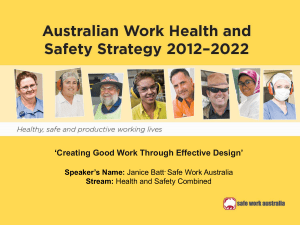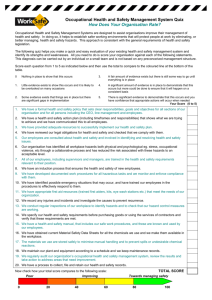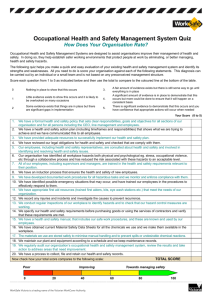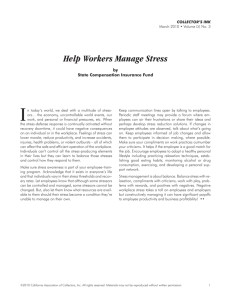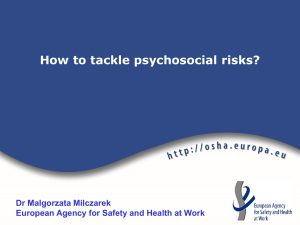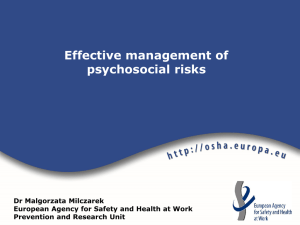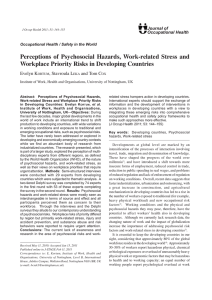Stress Presentation Susan Gee July 2015
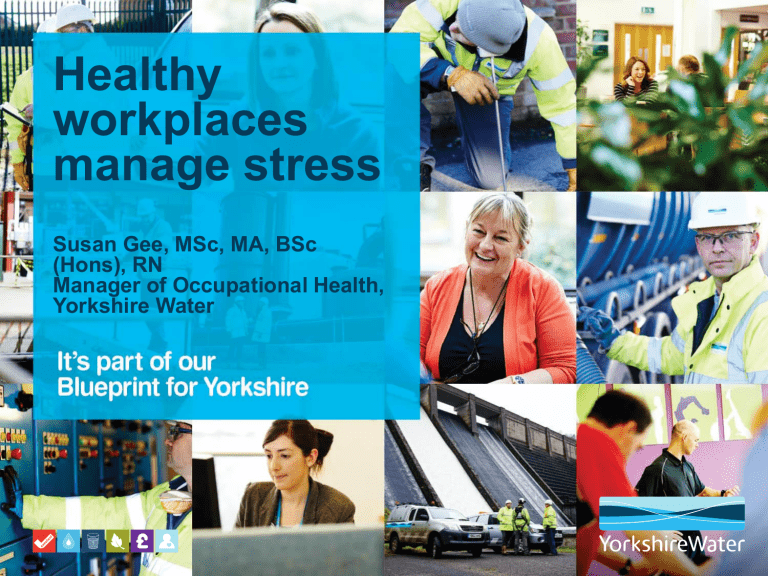
Healthy workplaces manage stress
Susan Gee, MSc, MA, BSc
(Hons), RN
Manager of Occupational Health,
Yorkshire Water
Key objectives
• Raising awareness about the growing problem with stress and psychosocial risks
• Focus on the positive effects of successful psychosocial risk management, including the business case
• Provide and promote the use of a simple and practical tool and guidance for managing psychosocial risks and stress in the workplace
Raising awareness
• Over half of European workers report that stress is common in their workplace.
• Around 4 in 10 workers think that stress is not handled well in their workplace.
Better understanding
Psychosocial risks time pressure, excessive demands, poor work organisations, job insecurity, role ambiguity, harassment, violence, lack of influence, lack of support, poorlymanaged organisational change, conflicting demands at work and home, etc
Work-related
Stress work demands are beyond capacity to cope with them
organisational issue, not individuals’ fault
Non work-related factors major life events, serious illness, bereavement, etc
Negative outcomes
Emotional irritability, anxiety, low mood, sleeping problems
Cognitive difficulty in concentrating, learning new things, making decisions, negative thinking
Behavioural making errors, becoming withdrawn or aggressive, substance abuse
Physical and mental illhealth depression, burn-out, PTSD, cardiovascular diseases
Better understanding
The negative effects for organisation:
– Poor overall business performance
– Increased absenteeism (about a half of all lost working days may be related to stress)
– Presenteeism (coming to work when ill and not able to perform well)
– Increased accident and injury rates
– Increased risk of litigation
– High turnover
Practical support
• Only about 30% of organisations in Europe have procedures in place for dealing with psychosocial risks*
• Dealing with those risks is often considered as more difficult compared to ‘traditional’ OSH risks (by 42% of managers) but…
• Psychosocial risks can be assessed and managed in the same systematic way as other OSH risks.
• The benefits of managing psychosocial risks and work-related stress outweigh the costs of implementation for organisations
* The European Survey of Enterprises on New and Emerging Risks (ESENER, 2010)
Psychosocial risks assessment
• Risk assessment for stress involves the same basic principles and processes as for other workplace hazards
- Raise awareness and ensure common understanding
- Identify hazards and those at risks
- Evaluate and prioritise risk
- Take action on preventive and corrective measures
- Document, monitor and review
The role of management
• Employers are responsible for implementing a plan to prevent or reduce psychosocial risks
• Employers should enable and encourage workers to raise concerns and suggestions
• Middle managers have a crucial role to play as they interact with workers on a daily basis
• Implementing voluntary measures to promote mental wellbeing can also make an important contribution to a healthy workplace
• It is important that managers accept the employee’s perception of the cause of their stress; this does not endorse or validate the employee’s view
The importance of employee participation
• It is essential that workers are consulted and involved in the process of managing psychosocial risks and stress
• Employees and their representatives have the best understanding of problems in their workplace and can help to shape planning and implement solutions
• A key component of the success of this approach is early intervention and active participation from the employee
• The risk assessment can be completed with employees who feel stressed and are at work
• If the employee is off work, the risk assessment must be completed BEFORE a return to work is facilitated
Stress Action Plan - Guidance for Managers
Stress is defined as a normal physiological response of an individual to pressures, which exceed that individual’s ability to cope. Issues at work or home, or both can cause it. Stress is a symptom complex not a disease in itself, but if severe or prolonged it can lead to mental Ill-health, such as anxiety or depression.
Under section 2 of the Health & Safety at Work Act 1974, an employer has a duty to ensure the health, safety and well-being of his employees at work. Implied in this is the duty to prevent both physical and psychological harm from work activities. This is now stated in the Management of
Health & Safety at work Regulations, which places a requirement on an employer to make a suitable and sufficient risk assessment of the hazards at work, including psychological hazards. The risk assessment must include:
Looking for pressures at work that could cause high or continuing levels of stress-there are eight key areas.
The nature of the job, work organisation, degree of control over the job, work environment. contractual arrangements, culture of the organisation, organisational change and work relationships
The Occupational Health team can provide management with an assessment tool to identify potential psychological hazards at work
Deciding whether enough is being done to prevent harm-the effectiveness of controls
Making a written statement of what stressors have been identified: what practical steps will be taken to deal with these pressures: the lead person responsible: the timescale for action and an assessment review date.
Since stress is currently one of the main risks to health and workers’ safety, a strategy is required that meets the workers needs and those of the organisation. Action to reduce work-related stress need not be complicated, time consuming or expensive. Intervention is generally positive not only for colleagues in terms of reduction of stress and improvement of health and well-being, but also for the function and success of the organisation. This action plan will allow employees to identify their perceived stressors and management to document any action taken or reason for inaction. It will also indicate a review date to facilitate audit of outcome of any intervention taken by management.
Outlined overleaf is a proposed Stress Management Action Plan. This can be used by managers to assess and monitor colleague’s perceived stressors and what they would like to happen to remove or reduce the stress levels.
Risk assessment can be carried out as part of colleague’s performance review and one to one discussion.
This plan should be used in conjunction with any of the above interventions. To complete the action plan colleagues should follow the explanation at the top of each column on how to complete each section. In the event of any questions please contact the OH team for help and advice.
Please note in many instances the cause of colleague’s stress may not be work-related. Nevertheless performing a Stress Management Action
Plan with the colleague may prove to be very worthwhile exercise in an attempt to define what reasonable practical steps the employer could take to support the individual through a difficult timea time when the individual’s ability to cope with the usual demands of employment may be temporarily reduced.
See over the page. Your team may wish to produce a document along the following lines.
Employee participation
What action colleague perceive is needed to prevent stress?
Action Taken by management Reason for Management in action
Review Date/Comments
Colleague’s perception of stressors
What colleague identifies as issues causing them stress
What action colleague perceives would remove or reduce their stress
What action can reasonably be taken by management?
Explanation of reasons for any action
Review date of assessment and/or any comments regarding issues
Focus on the positive effects
• Improved workers' well-being and job satisfaction
• A healthy, motivated and productive workforce
• Improved overall performance and productivity
• Reduced absence and staff turnover rates
• Compliance with legal requirements
• Reduced costs and burden on society as a whole
For further information…..
www.citizensadvice.org.uk
/ www.unison.org.uk/get-help/help-withproblems-at-home/there-for-you/support-therefor-you/ www.mindfulemployerleeds.wordpress.com/suc cess-stories/local/yorkshire-water/
Work-related Stress
Risk Assessment
Roles and Responsibilities
Senior Leaders are responsible for health & safety within their respective business areas. As such their stress management duties are:
• Ensure Line Managers undertake Work-related Stress Risk
Assessments, and that these are regularly reviewed
Safeguard Documents - Source Management Procedure MP 22 Stress Policy
Stress Management Guidelines
When considering which solutions are appropriate, the following should be taken into account;
• Ensure sufficient time is spent clarifying what the problem is – try and be as specific as possible as it will help develop effective solutions
• How did this area of work activity become a problem? Has it always been a problem? If not, what has changed?
• Is the problem a one-off? Is intervention really required? How will the solution solve the problem?
• How would the proposed solutions be introduced? Who will implement them? What will be the first tasks? How will you monitor progress?
• Prioritise the implementation of solutions according to the risk factor identified in the Risk
Assessment.
The Problem
•
How did this area of work activity become a problem?
• Has it always been a problem?
•
If not, what has changed?
The Options
•
Is the problem a one-off?
•
Is intervention required?
•
How will the solution solve the problem?
The Solution
• How would the proposed solutions be introduced?
•
Who will implement them?
• What will be the first tasks?
•
How will you monitor progress?
Completing the Risk Assessment
The steps for completing the risk assessment are as follows;
Step 1 - Identify the hazards
Step 2 – Decide who may be harmed and how
Step 3 – Evaluate the Risk and take Action
High (H)
Likely to cause harm, current control measures are inadequate.
Medium
(M)
Low (L)
Some risk to any member of staff, current control measures are inadequate and should be improved within a fixed timescale.
No significant risk to members of staff, current control measures are adequate.
Step 4 – Record the findings
Step 5 – Review and revise
Workplace Stressors
Any workplace factor that contributes to an individual being subject to excessive or prolonged pressure, or other types of demand placed on them.
Categorised within 6 management standards :-
- Demands
- Control
- Support
- Relationships
- Roles
- Change
Possible Solutions Guidance
On balance, how significant are the issues/concerns?
What has significant potential to cause stress?
What issues have team members identified?
What support measures are already in place to manage these issues?
What is already in place to manage these issues?
What more can be done at a local level to help?
Do any issues need escalating?
